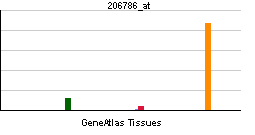HTN3
| Histatin 3 | |||||||||||
|---|---|---|---|---|---|---|---|---|---|---|---|
| Identifiers | |||||||||||
| Symbols | HTN3 ; HIS2; HTN2; HTN5 | ||||||||||
| External IDs | Template:OMIM5 | ||||||||||
| |||||||||||
| RNA expression pattern | |||||||||||
 | |||||||||||
| More reference expression data | |||||||||||
| Orthologs | |||||||||||
| Template:GNF Ortholog box | |||||||||||
| Species | Human | Mouse | |||||||||
| Entrez | n/a | n/a | |||||||||
| Ensembl | n/a | n/a | |||||||||
| UniProt | n/a | n/a | |||||||||
| RefSeq (mRNA) | n/a | n/a | |||||||||
| RefSeq (protein) | n/a | n/a | |||||||||
| Location (UCSC) | n/a | n/a | |||||||||
| PubMed search | n/a | n/a | |||||||||
Histatin 3, also known as HTN3, is a human gene.[1]
The primary protein encoded by HTN3 is histatin 3. Histatins are a family of small, histidine-rich, salivary proteins, encoded by at least two loci (HTN3 and HTN1). Post-translational proteolyitic processing results in many histatins: e.g., histatins 4-6 are derived from histatin 3 by proteolysis. Histatins are believed to have important non-immunological, anti-microbial function in the oral cavity.[1]
References
Further reading
- Troxler RF, Offner GD, Xu T; et al. (1990). "Structural relationship between human salivary histatins". J. Dent. Res. 69 (1): 2–6. PMID 2303595.
- vanderSpek JC, Offner GD, Troxler RF, Oppenheim FG (1990). "Molecular cloning of human submandibular histatins". Arch. Oral Biol. 35 (2): 137–43. PMID 2344289.
- Sugiyama K, Ogino T, Ogata K (1990). "Rapid purification and characterization of histatins (histidine-rich polypeptides) from human whole saliva". Arch. Oral Biol. 35 (6): 415–9. PMID 2372245.
- Sabatini LM, Azen EA (1989). "Histatins, a family of salivary histidine-rich proteins, are encoded by at least two loci (HIS1 and HIS2)". Biochem. Biophys. Res. Commun. 160 (2): 495–502. PMID 2719677.
- vanderSpek JC, Wyandt HE, Skare JC; et al. (1989). "Localization of the genes for histatins to human chromosome 4q13 and tissue distribution of the mRNAs". Am. J. Hum. Genet. 45 (3): 381–7. PMID 2773933.
- Oppenheim FG, Xu T, McMillian FM; et al. (1988). "Histatins, a novel family of histidine-rich proteins in human parotid secretion. Isolation, characterization, primary structure, and fungistatic effects on Candida albicans". J. Biol. Chem. 263 (16): 7472–7. PMID 3286634.
- Dickinson DP, Ridall AL, Levine MJ (1988). "Human submandibular gland statherin and basic histidine-rich peptide are encoded by highly abundant mRNA's derived from a common ancestral sequence". Biochem. Biophys. Res. Commun. 149 (2): 784–90. PMID 3426601.
- Sabatini LM, Azen EA (1994). "Two coding change mutations in the HIS2(2) allele characterize the salivary histatin 3-2 protein variant". Hum. Mutat. 4 (1): 12–9. doi:10.1002/humu.1380040103. PMID 7951254.
- Sabatini LM, Ota T, Azen EA (1993). "Nucleotide sequence analysis of the human salivary protein genes HIS1 and HIS2, and evolution of the STATH/HIS gene family". Mol. Biol. Evol. 10 (3): 497–511. PMID 8336540.
- Tsai H, Raj PA, Bobek LA (1997). "Candidacidal activity of recombinant human salivary histatin-5 and variants". Infect. Immun. 64 (12): 5000–7. PMID 8945538.
- Iontcheva I, Oppenheim FG, Offner GD, Troxler RF (2000). "Molecular mapping of statherin- and histatin-binding domains in human salivary mucin MG1 (MUC5B) by the yeast two-hybrid system". J. Dent. Res. 79 (2): 732–9. PMID 10728974.
- Naurato N, Wong P, Lu Y; et al. (2000). "Interaction of tannin with human salivary histatins". J. Agric. Food Chem. 47 (6): 2229–34. PMID 10794615.
- Gusman H, Travis J, Helmerhorst EJ; et al. (2001). "Salivary histatin 5 is an inhibitor of both host and bacterial enzymes implicated in periodontal disease". Infect. Immun. 69 (3): 1402–8. doi:10.1128/IAI.69.3.1402-1408.2001. PMID 11179305.
- Grogan J, McKnight CJ, Troxler RF, Oppenheim FG (2001). "Zinc and copper bind to unique sites of histatin 5". FEBS Lett. 491 (1–2): 76–80. PMID 11226423.
- Gyurko C, Lendenmann U, Helmerhorst EJ; et al. (2002). "Killing of Candida albicans by histatin 5: cellular uptake and energy requirement". Antonie Van Leeuwenhoek. 79 (3–4): 297–309. PMID 11816973.
- Baev D, Li XS, Dong J; et al. (2002). "Human salivary histatin 5 causes disordered volume regulation and cell cycle arrest in Candida albicans". Infect. Immun. 70 (9): 4777–84. PMID 12183519.
- Strausberg RL, Feingold EA, Grouse LH; et al. (2003). "Generation and initial analysis of more than 15,000 full-length human and mouse cDNA sequences". Proc. Natl. Acad. Sci. U.S.A. 99 (26): 16899–903. doi:10.1073/pnas.242603899. PMID 12477932.
- Li XS, Reddy MS, Baev D, Edgerton M (2003). "Candida albicans Ssa1/2p is the cell envelope binding protein for human salivary histatin 5". J. Biol. Chem. 278 (31): 28553–61. doi:10.1074/jbc.M300680200. PMID 12761219.
- Ahmad M, Piludu M, Oppenheim FG; et al. (2004). "Immunocytochemical localization of histatins in human salivary glands". J. Histochem. Cytochem. 52 (3): 361–70. PMID 14966203.
- Castagnola M, Inzitari R, Rossetti DV; et al. (2004). "A cascade of 24 histatins (histatin 3 fragments) in human saliva. Suggestions for a pre-secretory sequential cleavage pathway". J. Biol. Chem. 279 (40): 41436–43. doi:10.1074/jbc.M404322200. PMID 15272024.
| This protein-related article is a stub. You can help Wikipedia by expanding it. |